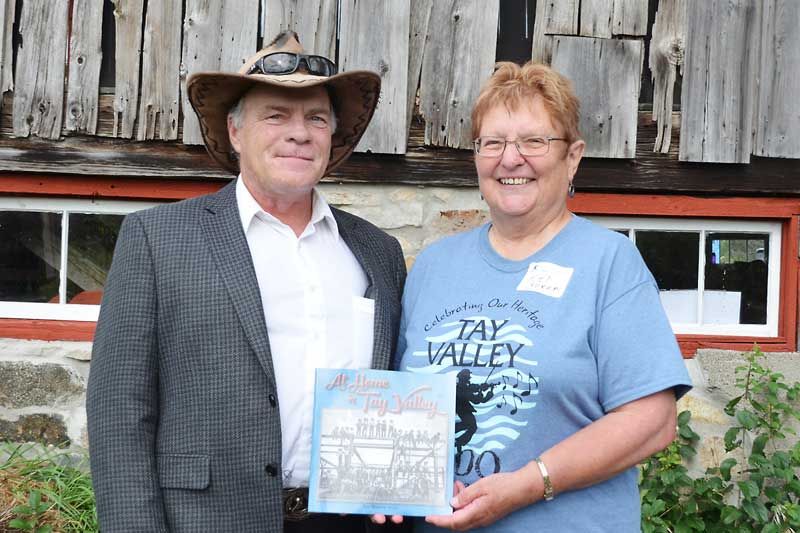Jeff Green | Oct 08, 2015
In 1816, the Perth Military Settlement was founded. The first settlements were established in the Town of Perth and vicinity, and in Bathurst and Burgess townships, two of the three townships that would eventually become Tay Valley Township. A few years later, in about 1820, settlement began in what became South Sherbrooke Township. In 1998, the three townships were amalgamated and became Bathurst, Burgess, and Sherbrooke, and was re-named Tay Valley Township in 2002, in recognition of the Tay River, the major watershed running through the township.
With the 200th anniversary of the founding of both Tay Valley and Perth now just three months away, events are already starting to crop up to mark it.
On September 19 at the EcoTay Education Centre, the results of an ambitious “book bee” were unveiled with the launch of the book At Home in Tay Valley, which was edited by Kay Rogers and features contributions by about 60 people.
The book launch itself was a big event, with many of the contributors attending along with their families and interested local residents, as well as dignitaries, including Tay Valley reeve, Keith Kerr, and the Lieutenant Governor of Ontario, The Hon. Elizabeth Dowdeswell.
As an aside, the Lieutenant Governor belied some of the formality of her title at what was, after all, a rural Ontario event where there is normally not much truck for pomp and circumstance. Since it was raining off and on throughout the afternoon of the launch, officials decided to scrap plans for Her Honour to walk through the potentially muddy grounds at EcoTay to the converted barn where the book launch was taking place.
Elizabeth Dowdeswell overturned the plan, however, insisting on braving the elements to follow the schedule that had originally been laid out by Tay Valley.
At Home in Tay Valley is made up primarily of accounts by family members of people who settled in the area in the 19th and early 20th centuries, and they paint a picture of the community ties, the challenges of transportation and working the land without the technological advances that we enjoy today, and of the consequences of hard work and smart investments
In the account by Bud Vanalstine from Maberly, he talks about how his grandfather, Edward Vanalstine, received a land grant for a property near Pine Lake, in North Frontenac, in 1885. His father, Don, worked in the timber shanties as a young man. In 1923, he married Rosetta Brown from Denbigh and they settled on a 400 acre farm, Lot 17, Con. 9 South Sherbrooke in 1931. They had one daughter and six sons before Rosetta died of the flu, just a week after their youngest son, Bud, was born. With his second wife, Jean Allan, Don had five more children. As Bud recalls, the farm was successful enough to produce more than enough food for the family, and up to 15 head of cattle each year for sale.
In the '30s there was no market for beef or produce, and although Bud remembers being well fed through the Depression years, clothing and shoes were not easy to come by. All in all, however, he considers that his father was a very successful farmer, who took advantage of the boom years following World War II and ended up amassing 2,450 acres of land and managing a herd of up to 115 head of cattle.
At Home in Tay Valley is chock full of accounts and anecdotes, including a description of the process of turning flax and fleece into linen, travelling by horse and sleigh through storms, road construction and more.
It also includes chapters on geology and archaeological history around some of the lakes, including Bobs Lake, where artifacts from as far back as the archaic age (5,000 to 1,000 BC) have been found.
Paula Sherman, from the Indigenous Studies Department of Trent University, has also contributed a chapter on the Omamiwinini people who frequented what are now Tay Valley, Bedford, and North Frontenac Townships at the time of immigrant settlement in those territories.
The Omamiwinini hunted and fished seasonally in the Mississippi, Madawaska, Rideau and other watersheds for centuries, maintaining ties through Grand Council gatherings in the summer on the Kiji Sibi (Ottawa) River.
Everything changed with the building of the Rideau Canal in 1820 and the lumbering that took place before and after that date.
Still, in the 1861 census there were 176 Omamiwinini in Renfrew County (aside from those living at Pikwakanagan). The 1871 census shows 26 families in Carleton, 30 in Lanark and 17 in Frontenac.
On the cover of At Home in Tay Valley, there is a copy of a photograph from J.J Moodie, on Scotch Line in the former Burgess Township. About 45 men are pictured, sitting in front of and on the timbers for a barn that was being raised that day. Kay Rogers said that the picture was chosen for the cover not only because of its age, but because it showed how, much like the book and the township itself, a group effort is required to build something of substance and staying power.
More Stories
- Sticker Shock - EV Charging Station To Cost North Frontenac Township
- 30th Anniversary Verona Car Show
- The Forgotten Comfort Veg - Eggplant
- MERA Stage Comes Alive This Fall
- North Frontenac Council Report - August 27
- Addington Highlands Council Report - September 2
- Here's Grief - Have You Met
- Burn Ban Off in North Frontenac, Addington Highlands - Reduced to Level One in South and Central Frontenac
- The Resurgent Sharbot Lake County Inn and Crossing Pub
- Towards Then End of Trail

